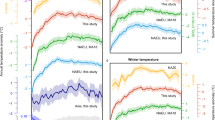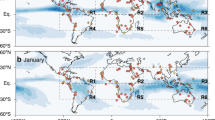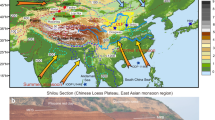Abstract
The position of the intertropical convergence zone is an important control on the distribution of low-latitude precipitation. Its position is largely controlled by hemisphere temperature contrasts1,2. The release of aerosols by human activities may have resulted in a southward shift of the intertropical convergence zone since the early 1900s (refs 1, 3, 4, 5, 6) by muting the warming of the Northern Hemisphere relative to the Southern Hemisphere over this interval1,7,8, but this proposed shift remains equivocal. Here we reconstruct monthly rainfall over Belize for the past 456 years from variations in the carbon isotope composition of a well-dated, monthly resolved speleothem. We identify an unprecedented drying trend since ad 1850 that indicates a southward displacement of the intertropical convergence zone. This drying coincides with increasing aerosol emissions in the Northern Hemisphere and also marks a breakdown in the relationship between Northern Hemisphere temperatures and the position of the intertropical convergence zone observed earlier in the record. We also identify nine short-lived drying events since ad 1550 each following a large volcanic eruption in the Northern Hemisphere. We conclude that anthropogenic aerosol emissions have led to a reduction of rainfall in the northern tropics during the twentieth century, and suggest that geographic changes in aerosol emissions should be considered when assessing potential future rainfall shifts in the tropics.
This is a preview of subscription content, access via your institution
Access options
Subscribe to this journal
Receive 12 print issues and online access
$259.00 per year
only $21.58 per issue
Buy this article
- Purchase on Springer Link
- Instant access to full article PDF
Prices may be subject to local taxes which are calculated during checkout




Similar content being viewed by others
References
Hwang, Y. T., Frierson, D. M. W. & Kang, S. M. Anthropogenic sulfate aerosol and the southward shift of tropical precipitation in the late 20th century. Geophys. Res. Lett. 40, 2845–2850 (2013).
Broccoli, A. J., Dahl, K. A. & Stouffer, R. J. Response of the ITCZ to Northern Hemisphere cooling. Geophys. Res. Lett. 33, L01702 (2006).
Rotstayn, L. D. & Lohmann, U. Tropical rainfall trends and the indirect aerosol effect. J. Clim. 15, 2103–2116 (2002).
Chang, C. Y., Chiang, J. C. H., Wehner, M. F., Friedman, A. R. & Ruedy, R. Sulfate aerosol control of tropical Atlantic climate over the twentieth century. J. Clim. 24, 2540–2555 (2011).
Zhang, X. et al. Detection of human influence on twentieth-century precipitation trends. Nature 448, 461–465 (2007).
Lu, H. Y. et al. Variation of East Asian monsoon precipitation during the past 21 k.y. and potential CO2 forcing. Geology 41, 1023–1026 (2013).
Friedman, A. R., Hwang, Y. T., Chiang, J. C. H. & Frierson, D. M. W. Interhemispheric temperature asymmetry over the twentieth century and in future projections. J. Clim. 26, 5419–5433 (2013).
Booth, B. B. B., Dunstone, N. J., Halloran, P. R., Andrews, T. & Bellouin, N. Aerosols implicated as a prime driver of twentieth-century North Atlantic climate variability. Nature 484, 228–232 (2012).
Dykoski, C. A. et al. A high-resolution, absolute-dated Holocene and deglacial Asian monsoon record from Dongge Cave, China. Earth Planet Sci. Lett. 233, 71–86 (2005).
Haug, G. H., Hughen, K. A., Sigman, D. M., Peterson, L. C. & Rohl, U. Southward migration of the intertropical convergence zone through the Holocene. Science 293, 1304–1308 (2001).
Zhang, P. Z. et al. A test of climate, sun, and culture relationships from an 1810-year chinese cave record. Science 322, 940–942 (2008).
Diffenbaugh, N. S. & Field, C. B. Changes in ecologically critical terrestrial climate conditions. Science 341, 486–492 (2013).
Poveda, G., Waylen, P. R. & Pulwarty, R. S. Modern climate variability in northern South America and southern Mesoamerica. Palaeogeogr. Palaeoclimatol. 234, 3–27 (2006).
Heyman, W. D. & Kjerfve, B. Hydrological and oceanographic considerations for integrated coastal zone management in southern Belize. Environ. Manage. 24, 229–245 (1999).
Frappier, A., Sahagian, D., Gonzalez, L. A. & Carpenter, S. J. El Niño events recorded by stalagmite carbon isotopes. Science 298, 565 (2002).
Webster, J. W. et al. Stalagmite evidence from Belize indicating significant droughts at the time of Preclassic Abandonment, the Maya Hiatus, and the Classic Maya collapse. Palaeogeogr. Palaeoclimatol. 250, 1–17 (2007).
Kennett, D. J. et al. Development and disintegration of Maya political systems in response to climate change. Science 338, 788–791 (2012).
Wilson, R. et al. Reconstructing ENSO: The influence of method, proxy data, climate forcing and teleconnections. J. Quat. Sci. 25, 62–78 (2010).
Esper, J., Cook, E. R. & Schweingruber, F. H. Low-frequency signals in long tree-ring chronologies for reconstructing past temperature variability. Science 295, 2250–2253 (2002).
Kawase, H. et al. Physical mechanism of long-term drying trend over tropical North Africa. Geophys. Res. Lett. 37, L09706 (2010).
Bollasina, M. A., Ming, Y. & Ramaswamy, V. Anthropogenic aerosols and the weakening of the South Asian summer monsoon. Science 334, 502–505 (2011).
Lau, K. M., Kim, M. K. & Kim, K. M. Asian summer monsoon anomalies induced by aerosol direct forcing: The role of the Tibetan Plateau. Clim. Dynam. 26, 855–864 (2006).
Leibensperger, E. M. et al. Climatic effects of 1950:2050 changes in US anthropogenic aerosols: Part 1: Aerosol trends and radiative forcing. Atmos. Chem. Phys. 12, 3333–3348 (2012).
Tokinaga, H. & Xie, S. P. Weakening of the equatorial Atlantic cold tongue over the past six decades. Nature Geosci. 4, 222–226 (2011).
Highwood, E. J., Stevenson, D. S., Highwood, E. J. & Stevenson, D. S. Atmospheric impact of the 1783–1784 Laki eruption: Part II - climatic effect of sulphate aerosol. Atmos. Chem. Phys. 3, 1177–1189 (2003).
Zielinski, G. A. et al. Record of volcanism since 7000-BC from the GISP2 Greenland ice core and implications for the volcano-climate system. Science 264, 948–952 (1994).
Haywood, J. M., Jones, A., Bellouin, N. & Stephenson, D. Asymmetric forcing from stratospheric aerosols impacts Sahelian rainfall. Nature Clim. Change 3, 660–665 (2013).
Oman, L., Robock, A., Stenchikov, G. L. & Thordarson, T. High-latitude eruptions cast shadow over the African monsoon and the flow of the Nile. Geophys. Res. Lett. 33, L18711 (2006).
Marland, G., Andres, R. J. & Boden, T. A. in Trends ’93: A Compendium of Data on Global Change (eds Boden, T. A., Kaiser, D. P., Sepanski, R. J. & Stoss, F. W.) 505–584 (Oak Ridge Nat. Lab., 1994).
Robertson, A. et al. Hypothesized climate forcing time series for the last 500 years. J. Geophys. Res. 106, 14783–14803 (2001).
Acknowledgements
This research was supported by funding from: the European Research Council (grant 240167 to J.U.L.B.); National Science Foundation of the United States (grant BCS-0620445 to K.M.P., grant HSD-0827305 to K.M.P. and Y.A., grant HSD-0827275 to D.J.K., and grant BCS-0940744 to D.J.K. and M.Z.); the Alphawood Foundation (grant to K.M.P.); the Schweizer National Fund, Sinergia (grant CRSI22 132646/1 to S.F.M.B.). Research permits were issued by the Belize Institute of Archaeology. Hydromet Belize are thanked for meteorological data.
Author information
Authors and Affiliations
Contributions
H.E.R. produced the stable isotope record with assistance from C.G.M. and J.L.P. Y.A., V.P. and V.V.A. were responsible for developing the uranium-series chronology. D.J.K. and B.J.C. performed radiocarbon analyses. H.E.R., K.M.P. and J.U.L.B. contributed significantly to fieldwork. M.Z. and T.X. performed GHCN analyses. F.A.L. and S.F.M.B. performed high-resolution stable isotope reanalyses. H.E.R. and J.U.L.B. wrote the manuscript. J.A. contributed to logistics associated with fieldwork. All named co-authors contributed to the project, discussed manuscript ideas and approved the final manuscript.
Corresponding author
Ethics declarations
Competing interests
The authors declare no competing financial interests.
Supplementary information
Supplementary Information
Supplementary Information (PDF 13591 kb)
Supplementary Information
Supplementary Information (XLSX 642 kb)
Rights and permissions
About this article
Cite this article
Ridley, H., Asmerom, Y., Baldini, J. et al. Aerosol forcing of the position of the intertropical convergence zone since ad 1550. Nature Geosci 8, 195–200 (2015). https://doi.org/10.1038/ngeo2353
Received:
Accepted:
Published:
Issue Date:
DOI: https://doi.org/10.1038/ngeo2353
This article is cited by
-
Last glacial hydroclimate variability in the Yucatán Peninsula not just driven by ITCZ shifts
Scientific Reports (2023)
-
Decline in seasonal predictability potentially destabilized Classic Maya societies
Communications Earth & Environment (2023)
-
Climate responses in China to domestic and foreign aerosol changes due to clean air actions during 2013–2019
npj Climate and Atmospheric Science (2023)
-
Aerosols overtake greenhouse gases causing a warmer climate and more weather extremes toward carbon neutrality
Nature Communications (2023)
-
Volcanic effects on climate: recent advances and future avenues
Bulletin of Volcanology (2022)



